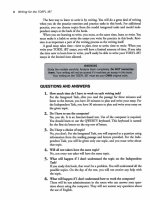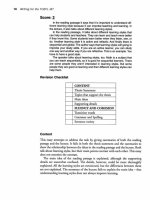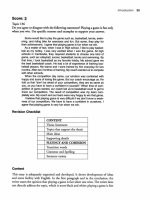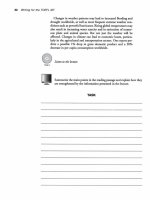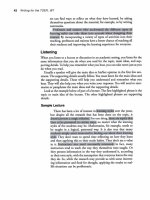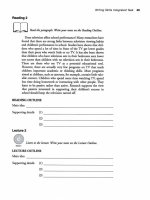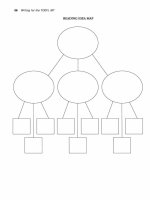writing for the toefl ibt: phần 1
Bạn đang xem bản rút gọn của tài liệu. Xem và tải ngay bản đầy đủ của tài liệu tại đây (66.3 KB, 17 trang )
writing for the i=
@
— i es ss = WITH AUDIO CD
4TH EDITION
Dr. Lin Lougheed
M@ Get the instruction and advice you need to succeed on the TOEFL's Independent
Task, the all-important essay question
@ Learn skills to gather ideas effectively, organize details, and develop your topic
into a clear, grammatical essay in English
@ Prepare for the TOEFL's Integrated Task, which tests your reading, listening, and
writing skills
M@ Strengthen your skills with the included Integrated Task models
ENCLOSED AUDIO T™TOEFL is a registered trademark of
ee: is a registere!
Cc PRES NTS Educational Testing Service (ETS). This publication is not endorsed or
approved
by ETS.
CTURES LIKE THOS) ON ACTUAL TEST
|
BARRON’S
Aa A A A BA BA AA A
riting for the
OEFL IBT
wv
i Oi Be < aN Kod Va aeuntt “~
te SrfElilake <, ‘ °y ieee arth 12 Uh 1 soot ) iO Be = 1} B= |S
4TH EDITION
Lin Lougheed Ed.D., Teachers College Columbia University
N@
BARRON'S ™ TOEFL is a registered trademark of Educational Testing Service (ETS).
This publication is not endorsed or approved by ETS.
Aa A A AMA AMA AA Aa A A V Published in 2011, 2008, 2004, 2000 by Barron's
Educational Series, Inc. Text © Copyright 2011, 2008 by Lin Lougheed.
Text © Copyright 2004, 2000 by Lin Lougheed, under the title Barron's How to
Prepare for the TOEFL Essay.
Text design and cover © copyright 2011, 2008, 2004, 2000 by Barron’s Educational
Series, Inc.
All rights reserved. No part of this publication may be reproduced or distributed in
any form or by any means without the written permission of the copyright owner.
All inquiries should be addressed to: Barron’s Educational Series, Inc. 250 Wireless
Boulevard Hauppauge, NY 11788 www.barronseduc.com
Library of Congress Catalog Card No. 2011010828 ISBN-13: 978-1-4380-7089-6
Library of Congress Cataloging-in-Publication Data
Lougheed, Lin, 1946- Writing for the TOEFL iBT / Lin Lougheed. — 4th ed. p. cm.
Includes bibliographical references. ISBN 978-1-4380-7089-6 1. Test of English as a
Foreign Language—Study guides. 2. English language—Textbooks for foreign
speakers. 3. English language—Examinations—Study guides. I. Title.
PE1128.L658 2011 428.2'4076—dc22 2011010828
PRINTED IN THE UNITED STATES OF AMERICA 987654321
s . , FSC Mixed Sources Product group from well-managed
forests and other controlled sources
Cert no. SW-COC-002507 www.fscorg © 1996 Forest Stewardship Council Contents
Ro ER “EE 6 XE CS. SE EEE ; A CUNEO Write the Response 70 Introduction 1
Summarizing 70 How to Use This Book 1 iad 6 72 Questions and Answers 2 Step 3:
Revise 80 To the Teacher 4 Use che REaision Checklist 80 Expanding the Activities 5
Practice 1 101 Integrated Task 5 Practice 2 106 Independent Task 5 Check the
Spelling and Punctuation 107 Writing Skills 6 Spelling | 107 Overview 7 Runctuation
107 Question Types 7 Practice a 109 Scoring—Integrated Task 10 ; Practice 4 111
Scoring—Independent Task 7 Practice Integrated Task 114 ri “ee Me Writing Skills:
Integrated Task 26 Independent Task 115 Independent Task 29 Step 1: Plan us . .
Write a Thesis Statement 115 Writing Skills: Presioes'1 nd Integrated Task 33 Make
Notes About General Ideas Step 1: Plan 33 and Specific Details 118 How to Take
Notes 33 Outlines 118 Reading 33 Heactice 2 120 Listening 34 Practice 3 122
Outlines and Idea Maps 35 Idea Maps 126 Practice 1 40 Renstite 4 130 Practice 2 44
Pr actice 5 134 Step 2: Write 56 Step as Write 138 Write a Thesis Statement 56 Write
the Introduction ie Point of View 56 State Your Opinion 138 Practice 1 57 Practice 1
139 Compare and Contrast 58 Practice 2 140 Practice 2 59 Practice 3 140 Write the
Supporting Details 60 Pracelee 4 141 Paraphrasing 60 Practice 5 142 Practice 3 61
Practice 6 143 Practice 4 65 Guide a Reader 143 Citing 67 Practice 7 145 Practice 5
69 Write the Paragraphs 146 Practice 8 147 iv Writing for the TOEFL iBT
Write the Conclusion Practice 9 Step 3: Revise Use the Revision Checklist Practice 1
Practice 2 Check the Spelling and Punctuation Practice 3 Practice Independent Task
Writing Skills— Both Tasks Transition: Connecting and Linking
Transition Words
Comparison and Contrast Cause and Effect Explanation Adding More Information
Practice 1 Variety: Words and Sentences Synonyms Practice 2 Practice 3 Pronouns
Parallel Structures Practice 4 Coherence Practice 5
Practice 6
150 151 152 152 172 178 181 182 184
185
185 185 186 187 187 187 188 189 189 190 192 193 194 196 197 198 199
Sentences Practice 7
Subject Practice 8
Voice Practice 9 Practice 10
Model Tests
Model Test 1—Integrated Task Model Test 1—Independent Task Model Test 2—
Integrated Task Model Test 2—Independent Task Model Test 3—Integrated Task
Model Test 3—Independent Task Model Test 4—Integrated Task Model Test 4—
Independent Task
Appendix
Model Essays Model Essays: Integrated Tasks Model Essays: Independent Tasks
Answer Key Integrated Tasks Independent Tasks Both Tasks Audioscripts
200 201 202 202 203 204 205
207
207 209 210 211 212 214 215 217
219
219 219 225 335 335 347 352 355
CHAPTER
Introduction
el fy is] a i] G&G ea,
" he Writing section of the TOEEFL® Internet-based Test (iBT) includes two
writing tasks: an Integrated Task and an Independent Task.
INTEGRATED TASK
This task consists of a 250-300 word passage on an academic subject followed by a
two-minute lecture or discussion on the same topic. The test taker is then given a
question about the topic. The test taker must write a 150- to 225-word summary of
the important points made in the listening passage and explain how these points
relate to those in the reading passage. The test taker may write more than 225
words if time permits.
INDEPENDENT TASK
This task asks for an opinion about a topic. The test taker will use personal knowledge and experience to write an essay of at least 300 words to answer the question.
The test taker may write more than 300 words if time permits.
The test taker has a total of 50 minutes to complete these two essays: 20 minutes for
the Intergrated Task and 30 minutes for the Independent Task. Both essays must be
written on the computer; they cannot be written by hand. The essays are then
scored by two or more readers on ETS’s Online Score Network. Each essay receives a
score of 0-5.
How to Use This Book
There are three steps in creating an essay: planning, writing, and revising. Writing
for the TOEFL iBT provides a step-by-step guide for planning, writing, and revising
your essays for both the Integrated Task and the Independent Task on the TOEFL
iBT. You will learn to follow a simple three-step model and practice applying it to
writing both types of essays.
Step 1 PLAN Step 2 WRITE Step3 REVISE
2 Writing for the TOEFL iBT
Ue
Warning
Study the models carefully. Analyze them completely. Do NOT memorize them. Your
writing will not be scored if it matches an essay in this book. Your writing on the
TOEFL iBT must be your OWN original work.
You will have 20 minutes to plan, write, and revise your essay for the Integrated
Task, and you will have 30 minutes to plan, write, and revise your essay for the
Independent Task. In those limited amounts of time, you must produce writing that
is clear, coherent, and correct. This book will help you do that.
Just as you must plan your essays, you also need to plan your studying. This book
provides you with a plan for studying for the TOEFL iBT essays. By following the
chapters in the book in order and doing all the practice exercises, you will learn a
three-step method for writing your essays, and you will have many opportunities to
practice writing. You will also learn writing skills that you can apply to both tasks
and to your writing in general.
The best way to learn to write is by writing. You will do a great deal of writing when
you do the practice exercises and practice tasks in this book. For additional practice,
you can choose topics from the model integrated tasks and model inde- pendent
essays at the back of the book.
When you are learning to write, you must, at the same time, learn to revise. You must
make it a habit to revise the essays you write for practice in this book. Revision is as
important a part of the writing process as the writing itself.
A good essay takes time—time to plan, time to write, time to revise. When you write
your TOEFL iBT essays, you will have a limited amount of time. If you take the time
now to learn how to write, you'll easily be able to write your TOEFL iBT essays in the
limited time allowed.
SISTERS SEE OA
_ Questions and Answers _
How much t time do | have to work on each writing task?
For the Integrated Task, after you read the passage for three minutes and listen to
the lecture, you have 20 minutes to plan and write your essay. For the Independent
Task, you have 30 minutes to plan and write your essay on the given topic.
Do | have to use the computer?
Yes, you do. It is an Internet-based test. Use of the computer is required. You should
learn to use the QWERTY keyboard. This keyboard is named for the first six letters
on the top row of letters.
Do | have a choice of topic?
No, you don’t. For the Integrated Task, you will respond to a question using information from the reading passage and lecture provided. For the Independent Task,
you will be given only one topic, and you must write about that topic.
Will all test takers have the same topic?
No, not every test taker will have the same topic. What will happen if | don’t
understand the topic on the Independent Task?
If you study this book, that won't be a problem. You will understand all the possible
topics. On the day of the test, you will not receive any help with the topic.
What will happen if | don’t understand how to work the computer?
There will be test administrators in the room who can answer your questions about
using the computer. They will not answer any questions about the use of English.
What kind of pencils should | bring?
None. Everything you need to write your essays will be given to you at the testing
center. If you need extra pencils or paper, ask your test administrator.
Can | bring a clock with me?
No. Nothing can be brought into the test room. You can wear your watch or look at
the clock on the computer screen.
Can | bring a dictionary with me?
No. Nothing can be brought into the test room.
Can | bring paper with me? No. Nothing can be brought into the test room. Scratch
paper will be supplied.
What happens to the notes | take?
You can write your notes in English or your first language. They will be collected and
discarded. They will not be seen by the raters.
Is there a spell checker or grammar checker on the computer?
No. You will have to do your own proofreading. Don’t worry about a few spelling
errors or a few mistakes with punctuation or grammar. A few small errors will not
count against your score. Hint: If you are unsure how to spell a word, use a word you
do know how to spell.
How long should the writing sample be?
On the Integrated Task, you should write 150-225 words. You may write more if you
have time. On the Independent Task, you should write around 300 words. You may
write more if you have time.
What’s more important, organization or grammar?
Both are important. A reader judges an essay on its organization, the use of details to
support the main points, and your facility with English. See the section, Scoring the
Essay, for more information on this.
Introduction 3
4 Writing for the TOEFL iBT
What happens if | don’t finish?
You do not need to have an elegantly stated conclusion. What you do write should
demonstrate your facility with English. Do not end with an apology. Do not apologize to the reader for what you did not do or for what you think you should have
done better.
ae ee. fed) ay jes i oO ar | ws
Is there an extra fee for the writing section of the test? No. The test fee covers all
parts of the TOEFL.
Is the writing section required? Yes. All test takers who take the TOEFL must take
the writing section of the test.
How is my writing scored?
Two readers will read each essay and will give a score of 0-5. Neither reader will
know the score the other reader gives. If the scores are more than one point apart, a
third person will read your essay. Your score will then be converted to a scaled score
of 0-30.
Will | see my scores immediately?
No. Your scores will be available online and mailed to you approximately two weeks
after the test date.
What if | don’t like my scores?
Sign up to take the test again after you do all the exercises in this book a few more
times. You should see an improvement in your scores.
SERS TE SSB ES SRG TRIBE RE TS ST GE HESS ee a ee Eo
Writing for the TOEFL iBT presents ts step-by-step m methods for completing ie two
tasks in the writing section of the TOEFL. By following the steps in order, your
students will build new skills on top of previously developed ones. Although the
activities in this book are specifically aimed at the two writing tasks in the TOEFL,
your students will be learning skills that they can apply to their writing in general.
They will learn how to organize their thoughts, develop their essays, and use
appropriate sentence structure to express their ideas. The activities in this book are
well suited for classroom use. The activities are carefully structured and can easily
be completed in class. They can also be done as homework and then corrected in
class. Expanding the Activities INTEGRATED TASK
STEP
Plan
This book provides many opportunities for students to plan and practice taking
notes on reading passages and lectures. You can provide additional practice by
having the students take notes on passages that you or they supply. You can use
passages from reading texts, newspapers, magazines, and other sources that are
available and are of interest to the students. Encourage the students to read often
and to make notes on what they read. Students can bring their notes to class to share
with their classmates.
STEP
Ei Write
This book provides many opportunities for practice writing summaries of reading
passages and lectures. Again, you can provide additional practice by having the students write summaries of things they have read or news stories they have listened
to. Encourage students to share with the class summaries of interesting articles they
have read or movies or TV programs they have seen.
STEP
Ei Revise
While working on Step 3, students can practice revising by checking each other's
work, looking at the development, organization, grammar, punctuation, and spelling.
The Writing Skills section of the book provides practice with using transition words
and variety in sentence structure and can be studied in conjunction
with Step 3.
INDEPENDENT TASK
STEP
Plan
In order to plan their responses to the writing topics, students need to be able to
formulate opinions on these topics. They must get used to thinking about and
describing reasons and advantages or disadvantages. In small groups, students can
brainstorm and discuss their ideas on the writing topics presented throughout the
book and in the Appendix. Students can then practice writing thesis statements and
developing concept maps on the same subjects.
Introduction 5
6 Writing for the TOEFL iBT
STEP
Write
When the class is working on Steps 2 and 3, have the students check each other's
essays to make sure there is a topic sentence in each paragraph and that both the
theme and all the supporting points are mentioned in the introduction. Have the
students check the conclusion to make sure the theme is summarized there. The
model essays in the Appendix can be used for additional practice. Have the students
identify in a model essay the theme and supporting points in the introduction, topic
sentences in the body of the essay, and the summarized theme in the conclusion.
STEP
Ei Revise
While working on Step 3, students can practice revising by checking each other's
work using the revision checklist. Again, the Writing Skills section of this book can
be studied along with these steps.
= @ ed ci & o
WRITING SKILLS
While working on this section of the book, you can use the model essays in the
Appendix to provide additional practice. You can ask students to look in these essays
for examples of transition words, different types of sentences, parallel structure,
pas- sive and active voice, or whatever aspect of sentence writing you wish to focus
on.
(as A Word of Caution
Remind students NOT to memorize the essays in this book. An essay will not be
rated if the reader suspects it was copied from the model essays.
Introduction 7 Overview
Question Types INTEGRATED TASK
First, you will read a 250-300 word passage on an academic subject. You will have
three minutes to read.
Chapter 1
SAMPLE READING PASSAGE
Integrated Writing
Scientists work to genetically modify crops for various reasons. Sometimes the goal
may be to develop a crop that is resistant to disease or pesticides. Another goal is to
develop vegetables that have a longer shelf life. Or, the purpose may be to develop a
more nutritious form of a food plant. An example of the latter is golden rice. It was
developed by scientists in Europe. They took ordinary rice and inserted genes from
the yellow flower called daffodil, as well as from a bacterium. This gave the rice the
golden color from which it gets its name. More to the point, however, it added
vitamin A, 4 nutrient that rice does not normally have.
Vitamin A deficiency is a serious problem in many parts of the world. Vitamin A
deficiency can lead to blindness, compromised immunity,
ibility to infection, and premature death. Children are especially affected by lack of
this vitamin. According to the World Health Organization, | hundreds of thousands of
children go blind every year because of Vitamin AGeficiency.
Adding vitamin A to rice, which is a staple food in many of the areas where
mainutrition is common, can be an efficient way to address the problem,
Consumption of a varied diet would of course, be the most desirable way to address
nutritional needs. A number of vegetables, such as carrots and pumpkins, contain
high amounts of vitamin A and could address this vitamin deficiency. However,
because of tradition, economic consider- ations, and other issues, it is often not
possible to pursue this type of solution. By introducing golden rice into areas where
rice is already consumed on a daily basis, researchers hope to provide a source of
this vitamin that will become part of the normal diet.
Then, you will listen to a two-minute lecture or discussion on the same topic. You
can take notes while you listen.
SAMPLE AUDIO
Integrated Writing
Sia" x Posi WE Goa Oe
~
8 Writing for the TOEFL iBT
Here is the audio lecture. You will not be able to read this during the test. You will
only hear it.
SAMPLE AUDIO SCRIPT
There is a lot of controversy surrounding the issue of genetically modified foods.
Golden rice is a famous example. It has been intro- duced as an inexpensive and
effective way to address the problem of vitamin A deficiency in parts of the world
where rice is a staple food. It seems simple, but it is not so uncomplicated as it looks.
For one thing, the problem is not so straightforward as a lack of a vitamin that can be
solved by providing the vitamin. People living in areas where vitamin A deficiency is
an issue also suffer from lack of other vitamins and nutrients. So simply adding in a
particular vitamin is not going to solve the overall problem of malnutrition.
in addition, a solution such as golden rice treats malnutrition as an isolated problem
rather than what it really is — a symptom of the deeper issues of poverty. People
living in areas where lack of sufficient nutrition is a problem also suffer from other
lacks: lack of public health systems, of education, of sanitation, of economic power.
Eating golden rice will not make these problems go away.
Even looking at purely nutritional issues, golden rice is not the magic solution it has
been presented to be. For one thing, if consumed in nor- mal amounts, golden rice
would provide only about 10% of a child’s daily need of vitamin A. In addition, there
are other, better sources of this vitamin. A cup or less of sweet potatoes, leafy green
vegetables, or man- goes would provide all of a child’s daily need of vitamin A, and
would provide other nutrients as well. Clearly, we need to seek other solutions to the
problem.
SAMPLE QUESTION
Integrated Writing
Guestior: Summarize the points made in the eeu you fee fear explaining how they
cast doubt on points made in the reading
Scientists work to genetically modify crops for various reasons. Sometimes the goal
may be to develop a crop that is resistant to disease or pesticides. Another goal is to
develop vegetables that have a longer shelf life. Or, the Purpose may be to develop a
more nutritious form of a food plant. An example of the latter is golden rice. It was
developed by scientists in Europe. They took ordinary rice and inserted genes from
the yellow flower called daffodil, as well as from a bacterium. This gave the rice the
golden color trom which it gets its name. More to the point, however, it added
vitamin A, a nutrient that rice doesn't normally have.
Vitamin A deficiency is a serious problem in many parts of the world.
Vitamin A deficiency can lead to blindness, compromised immunity, ‘susceptibility to
infection, and premature death. Children are especially affected by lack of this
vitamin. According to the World Health Organization, hundreds of thousands of
children go blind every year because of vitamin A Geficiency.
Adding vitamin A to rice, which is a staple food in many of the areas where
malnutrition is common, can be an efficient way to address the problem.
Consumption of a varied diet would of course, be the most desitablo way to
4 address nutritional needs. A number of vegetables, such as carrots and
pumpkins, contain high amounts of vitamin A and could address this vitamin
deficiency. However, because of tradition, economic consider- ations, and other
issues, it is often not possible to pursue this type of solution. By introducing golden
rice into areas where rice is already consumed on a daily basis, researchers hope to
provide a source of this vitamin that will become part of the normal diet.
INDEPENDENT TASK
SAMPLE QUESTION
Independent Writing
Question: Do you agree or disagree with the following?
You should never tell a lie even if the truth may hurt someone.
Use specific reasons and examples to support your opinion.
Introduction 9
att ce 10 Writing for the TOEFL iBT Scoring-—Integrated Task
The Integrated Task essay is scored on a scale of 0 to 5. The scorers will look at how
well you addressed the task of summarizing and comparing the reading selec- tion
and the listening selection. They will also look at your use of correct gram- matical
forms and vocabulary.
S|
[ek ae ale a) ef i
Rating Scale
An essay at this level
— clearly and concisely summarizes the main points of the reading and the listening selections
— clearly and concisely explains how they support or contradict each other
— uses correct grammatical forms and appropriate word choice
— may have slight inaccuracies in the summary of ideas or occasional grammati- cal
errors
2.5-3.5 Fair
An essay at this level
— summarizes the main points of the reading and listening selections but may be
missing an idea or ideas or may be lacking in clarity
— may not accurately explain the relationship between the reading and listening
selections
— may lack clarity because of grammatical errors or inappropriate word choice
1.0—2.0 Limited
An essay at this level
— may demonstrate incomplete understanding of the reading or listening selections
— may not explain a clear relationship between the reading and listening selections
— may be difficult to read because of serious grammatical errors
(An essay that receives a score of 0 me be blank, written in another langage. « or not
relate to the topic.) SAMPLE SCORED ESSAYS
The author explains that understanding learning styles can improve learning and
train- ing. The speaker, however, suggests that understanding learning styles doesn’t
always provide a solution.
The author states that understanding learning styles helps individuals learn better
and professors and trainers instruct better. The author explains different ways to
describe learn- ing styles. Some people learn more easily by listening, others by
seeing, and still others by doing. Active learners understand new information by
doing something with it. Reflective learners understand information by thinking
about it. Sequential learners look at information as a series of steps, but global
learners prefer to look at the whole rather than the parts. The author believes that
understanding learning styles can improve study skills. Sequential learners, auditory
learners, and reflective learners, for example, can each GheoBs the study methods
that best suit their individual learning styles.
The speaker presents a different point of view. First, some subjects have to be taught
in certain ways. Math has to be taught sequentially. In addition, the speaker suggests
that stu- dents “simply aren’t interested” in information about learning styles. Some
professors aren’t interested in learning styles, either.
Content
This essay addresses the task by giving concise summaries of both the reading passage and the lecture and explaining clearly how the main ideas of both contrast with
each other.
The first paragraph states a clear thesis, explaining that the reading and the lecture
present contrasting ideas. The second paragraph supports the reading main idea by
summarizing the main points of the reading. The third paragraph supports the listening main idea by summarizing the main points of the listening. The paragraphs
have topic sentences and supporting details. In the body of the essay, the topic sentences of the paragraphs match the topics introduced in the first paragraph.
Fluency and Cohesion
The essay uses appropriate transition words such as for example, first, and in
addition. There are no grammar or spelling errors. The essay contains a variety of
sentence structures such as simple and compound sentences and adjective clauses.
Introduction 11
Note
The samples in this book include paragraph indents, but you will not be scored
down if you do not use them on the test.
12 Writing for the TOEFL iBT
~ SCORE: 4
The author explains that understanding learning styles can make learning and
training better. The speaker says the opposite, that knowing about learning styles
doesn’t always help teachers and students.
In the reading passage, the author says that understanding learning styles helps
students learn better and teachers teach better. The author explains the different
kinds learning styles. Some students learn by listening, some by seeing, and some by
doing. Also, some students are active learners. They need to do things with new
information. Sequential learners see information in sequence. The author says that if
you understand learning styles, can improve your study skills. Sequential learners
and auditory learners, for instance, they can choose the best study methods for their
learning styles.
The speaker has a different opinion. First, some things have to be taught in certain
ways. Math is an example. It has to be taught sequentially. Also, the speaker says that
students “simply aren’t interested” in information about learning styles. Some
professors don’t inter- ested in learning styles, either.
ed fo a p=) j= c G eS)
( REVISION CHECKLIST — : Cl Content - Q Fluency and Cohesion Thesis Statement |
Transition words — & Topics that support the 1 Grammar and Spelling thesis — Wf
Sentence Waricty at Main ideas : : ae CL) Supporting details v : : | 4 ) Content
This essay addresses the task by giving summaries of both the reading passage and
the lecture and explaining how the main ideas of each contrast with each other. The
writer left out a few supporting details from the summary of the reading. She mentioned active learners but not reflective learners. She mentioned sequential learners
but not global learners.
The thesis is clearly stated, explaining that the reading and the lecture present contrasting ideas. The second paragraph and third paragraph support the main ideas of
the reading passage and the lecture by summarizing the main points of each. In the
body of the essay, the topic sentences of the paragraphs match the topics introduced
in the first paragraph.
Fluency and Cohesion
The essay uses appropriate transition words such as for instance, first, and in
addition. There are a few grammar errors, but they don’t interfere with
understanding the essay.
... the different kinds learning styles. ... the different kinds of learning styles.
Introduction
... if you understand learning styles, can improve your study skills. ... if you
understand learning styles, you can improve your study skills.
Sequential learners and auditory learners, for instance, they can choose ... Sequential
learners and auditory learners, for instance, can choose . . .
Some professors don’t interested in learning styles, either. Some professors aren’t
interested in learning styles, either.
The essay contains a variety of sentence structures such as simple, compound, and
complex sentences.
The author explains that understanding learning styles can make learning and
teaching better, but the speaker says the opposite opinion. Even if teachers and
students know about learning styles, doesn’t always help them.
In the reading passage, it says that understanding different learning styles help
students and teachers better. They can improve learning. There are different kinds of
learning styles such as listening, seeing, and doing. In addition, there are active
learners and reflective learners. Finally, we have sequential learners and global
learners. The author says that learn- ing styles will improve your study skills. You
can to choose the best way to study for your learning style.
The speaker says the opposite. First, some things you have to teach them in certain
ways. Math is an example. Also, some people don’t like learning styles. Some
students and some professors don’t like different ways of learning. It’s too bad
because it can help them.
a ( REVISION CHECKLIST Q Content . 1 Fluency and Cohesion Thesis Statement
Transition words Topics that support the (1 Grammar and Spelling thesis Sentence
variety & Main ideas L ( Supporting details sy
Content
This essay addresses the task by giving summaries of both the reading passage and
the lecture and explaining how the main ideas of each contrast with each other. The
writer left out some supporting details from the summary of the reading. She mentioned the names of the different learning styles but did not explain what they are or
how they differ from each other. In the last paragraph, she mentioned math as an
example of something that has to be taught in a certain way but did not explain how
it was an example.
13
Chapter 1
14 Writing for the TOEFL iBT
There are some inaccuracies in explaining the supporting details of the lecture. The
essay states “Some students and some professors don't like different ways of
learning.” In the lecture, the speaker made the point that some people arent interested in thinking about learning styles. That is somewhat different than saying that
they don’t like learning styles.
Fluency and Cohesion
The essay uses appropriate transition words such as in addition, first, and also.
There are several grammar errors.
. doesn’t always help them. . it doesn’t always help them.
. different learning styles help students and teachers better. . different learning styles
help students and teachers do their work better.
You can to choose the best way... You can choose the best way...
First, some things you have to teach them in certain ways. First, you have to teach
some things in certain ways.
The essay contains a variety of sentence structures such as simple, compound, and
complex sentences.
in the reading passage it says that it is important to understand different learning
style because it can improbe teaching and learning. In the lecture, it also talks about
different learning styles.
In the reading passage, it talks about different learning styles that can help students
and teachers. They can learn and teach more better if they know this. Some students
learn better when they listen, see, or do. Another learning style it is active and
reflactiv. And finally there is sequential and global. The author says that learning
styles will going to improbe your study skills. If you are an active learner, you can
study one way and another way if you are reflactive. This is an example. You have to
have a good style.
The speaker talks about learning styles, too. Math is a subject that you can teach
sequen- tially, so it is good for sequential learners. There are some people they aren't
interested in learning styles. But some people they are good at learning and their
different learning styles can help them.
( REVISION CHECKLIST : 1 Content — “1 Fluency and Cohesion _ Thesis Statement _
Wf Transition words (1 Topics that support the _ 1 Grammar and Spelling © Thesis
Sentence variety ra Main ideas CY Supporting details L 8 . | Content
This essay attempts to address the task by giving summaries of both the reading
pas- sage and the lecture. It fails in both the thesis statement and the summaries to
show the relationship between the ideas in the reading passage and the lecture.
Both talk about learning styles, but their main points contrast with each other. This
essay does not mention the contrast.
The main idea of the reading passage is explained, although the supporting details
are somewhat confused. The details, however, could be more thoroughly explained.
All the learning styles are mentioned, but the differences between them are not
explained. The summary of the lecture fails to explain the main idea—that understanding learning styles does not always improve learning.
Fluency and Cohesion
The essay uses some transition words such as another and finally. There are several
grammar errors.
They can learn and teach more better. They can learn and teach better.
Another learning style it is active ... Another learning style is active...
The author says that learning styles will going to improve your study skills. The
author says that learning styles will improve your study skills.
There are some people they aren't interested in learning styles. There are some
people who aren't interested in learning styles.
There are also a few spelling errors.
immprebe =—s improve sottacthy reflective
The essay contains a variety of sentence structures such as simple, compound, and
complex sentences.
Introduction
15
Chapter 1

